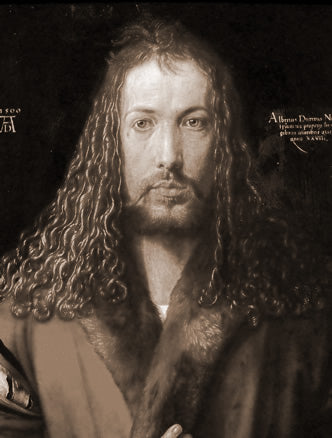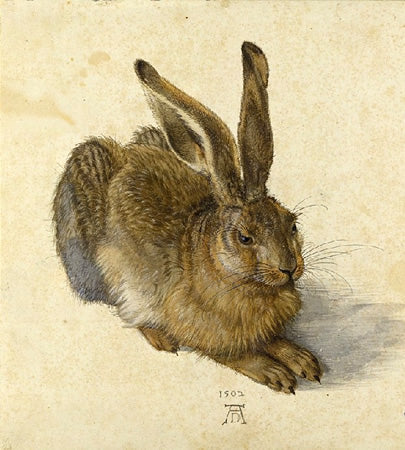Albrecht Dürer

| Birth Name: | Albrecht Dürer. |
|---|---|
| Spanish Name: | Alberto Durero. |
| Nationality: | Holy Roman Empire, now Germany. |
| Year of Birth: | 1471, Nuremberg. |
| Year of Death: | 1528, Nuremberg. |
| Style: | Renaissance, German school. |
Considered the leading figure of the German Renaissance, Albrecht Dürer was born with an innate ability and passion for the visual arts.
His preferred artistic technique was woodcut printing, especially drawings carved in wood on paper. His skill in this field was so remarkable that by the age of 20, he was already mingling with the leading artists of Europe, including Leonardo and Raphael.
The son of a renowned goldsmith and godson of the owner of Nuremberg's main print shop. Dürer grew up in an environment where work equaled artistic creation, his father tried to have him follow in his footsteps. The young man responded well and showed great skill in goldsmithing. However, his talent in graphic arts, which he learned from his godfather, eventually led him to dedicate his life to it.
Dürer's engravings are impeccably made, and their realism is astonishing, earning him work for the monarchy and the church from a young age.
In addition to engravings, he also produced oil paintings throughout his career, in which his great artistic skill is evident. Today, these are considered paradigms of European Renaissance. He not only focused on depicting figures on canvas but also made a rich conceptual and technical contribution to painting and religious symbolism.
Paintings by Dürer
The following is a selection of the 12 most famous paintings by Dürer.
-

"Adam and Eve"
Diptych painted by Alberto Durero in 1504, it is one of the most recognized pictorial representations to this day of the biblical story.
Separately, it shows the first two human inhabitants of the earth. Naked and covered with leaves, in both paintings the apple appears, in the case of Eve, the serpent also appears.
The composition is simple and eloquent, both characters seem to establish the biblical dialogue, where the woman, seduced by the serpent, naturally offers the forbidden fruit to the man, who open-mouthed willingly accepts everything the woman proposes.
The anatomical proportions of the two characters adhere to the classical standards of beauty, and the coloration of the canvas observes the strictest academic norms of the time. These canvases are currently located in the Prado Museum, in Madrid.
-

"Young Hare"
Also known as Feldhase, this is undoubtedly the most famous rodent portrait in history. Painted in watercolor on papyrus by Alberto Durero in 1502.
The descriptive work is so meticulous that the artist indicates it is a young specimen, as corroborated by its anatomical characteristics. The painting was created during a short period when the artist was interested in observing the environment and naturalism, a time when he also painted another of his famous nature-inspired works with photographic quality: "Great Piece of Turf".
The work is currently located in the Albertina Museum, Vienna.
-

"Adoration of the Magi"
A work by Alberto Durero, oil on wood panel, painted in 1504 commissioned by King Frederick III of Saxony.
The painting is notable for its many elements of the Italian Renaissance, which the artist began to gradually incorporate into his works. This piece, in particular, was created just after the artist's return from a trip to Venice, hence the composition shows clear influences of the Venetian school, especially in the colors used and the body postures of the characters. The figures recall typical traits in paintings by Bellini, Raphael, and Mantegna.
It is currently located in the Uffizi Gallery, Italy.
-

"Adoration of the Trinity"
Altarpiece by Alberto Durero, religious representation on wood, with oil and tempera paint, year 1511.
A model composition of the German Renaissance style, the upper part of the painting shows the Holy Spirit, the Father, and the Son, from top to bottom in this order, inscribed in an inverted triangle of clouds. The cross held up by angels is gazed upon by the crowd, which also floats in the clouds.
It is currently located in the Kunsthistorisches Museum Vienna.
-

"Self-Portrait at 26"
Self-portrait by Alberto Durero, it is one of the most recognized, with at least 4 compositions of himself at different ages attributed to the painter, this one specifically at the age of 26.
It is currently part of the collection of the Prado Museum, Madrid.
-

"The Four Apostles"
Religious painting by Alberto Durero, executed in oil on canvas between the years 1517 and 1526.
In the left canvas appear John and Peter, both looking at the gospel text written by the former. To the right are Mark (in the background), holding what is believed to be his gospel, and Paul (in white) holding the complete scripture, and a staff. The 4 characters create a dynamic with their gazes, with Saint Paul being the only one who looks outward.
The work was created in a historical context of the full Protestant Reformation, who by definition do not accept iconic images, considering them pagan. Therefore, Protestant creations were relegated to the private sphere, and not considered as religiously valuable pieces.
This diptych is currently located in the Alte Pinakothek, Munich.
-

"Feast of the Rosary"
A painting of a religious festival, painted by Alberto Durero in 1506. Considered the most representative and important painting of his career. An exquisite composition, recognized as such from the outset, it catapulted the painter to the highest spheres of fame and recognition.
The painting, presided over by the Virgin Mary and the Child, shows them bestowing a crown on the two kneeling characters, one on each side: Pope Julius II and Emperor Maximilian I of Habsburg.
It is currently part of the permanent exhibition of the National Gallery of Prague.
-

"Great Piece of Turf"
Watercolor by Alberto Durero, painted in his workshop in Nuremberg, in 1506. This, along with "Young Hare", are the most outstanding naturalistic drawings of the painter.
The quality is so high that the species of plants in the painting can be precisely identified.
It is currently located in the Albertina Museum, Vienna.
-

"Jesus among the Doctors"
A multiple portrait, with marked Renaissance characteristics, painted in oil on wood by Alberto Durero, at the age of 35, in 1506. A period in which his contemporaries already held him in high regard.
The composition unfolds in a dynamic of converging gazes on the main character, who thus naturally stands out. The placid expressions and rich coloring are the most identifiable elements of the Renaissance.
The painting currently belongs to the Thyssen-Bornemisza Museum in Madrid, where it is exhibited.
-

"Praying Hands"
An anatomical study of hands, drawn with black ink and white lead (lead white), on blue paper, by Alberto Durero in 1508. Also known as "Study of an Apostle's Hands".
Considered masterful for its descriptive perfection and simplicity.
It is currently located in the Albertina Museum, in Vienna, Austria.
-

"The Martyrdom of the Ten Thousand Christians"
This is a painting considered very rare in the catalog of Alberto Durero, due to the chaotic aspect of the composition, the theme based on a legend, and the strange self-portrait that appears in the center of the canvas, where the artist holds a banner with his signature.
Painted in 1508 by commission of Frederick III of Saxony, who wanted to hang the painting in a room dedicated to Christian relics.
Dense vegetation, rugged terrain, and 140 characters divided between Europeans and Easterners, the latter annihilating the former, with all sorts of brutal tortures and methods.
The canvas is preserved in the Kunsthistorisches Museum Vienna, Austria.
-

"Portrait of Jakob Muffel"
Portrait by Alberto Durero, painted towards the end of his life, in 1526. The artist brings out all his talent, Renaissance stylistic, and realism to depict this fine portrait of Jakob Muffel, a public official in Nuremberg, who died that same year.
It is currently located in the Gemäldegalerie, in Berlin, Germany.
Order it in the section of custom oil paintings
Related:
↑Back to top